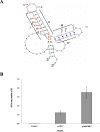Transcriptional and posttranscriptional regulation of Bacillus sp. CDB3 arsenic-resistance operon ars1
- PMID: 26355338
- PMCID: PMC4562236
- DOI: 10.7717/peerj.1230
Transcriptional and posttranscriptional regulation of Bacillus sp. CDB3 arsenic-resistance operon ars1
Abstract
Bacillus sp. CDB3 possesses a novel eight-gene ars cluster (ars1, arsRYCDATorf7orf8) with some unusual features in regard to expression regulation. This study demonstrated that the cluster is a single operon but can also produce a short three-gene arsRYC transcript. A hairpin structure formed by internal inverted repeats between arsC and arsD was shown to diminish the expression of the full operon, thereby probably acting as a transcription attenuator. A degradation product of the arsRYC transcript was also identified. Electrophoretic mobility shift analysis demonstrated that ArsR interacts with the ars1 promoter forming a protein-DNA complex that could be impaired by arsenite. However, no interaction was detected between ArsD and the ars1 promoter, suggesting that the CDB3 ArsD protein may not play a regulatory role. Compared to other ars gene clusters, regulation of the Bacillus sp. CDB3 ars1 operon is more complex. It represents another example of specific mRNA degradation in the transporter gene region and possibly the first case of attenuator-mediated regulation of ars operons.
Keywords: Arsenic resistance; Operon expression; RNA degradation; Transcription attenuation.
Conflict of interest statement
The authors declare there are no competing interests.
Figures





Similar articles
-
Sequencing and expression of two arsenic resistance operons with different functions in the highly arsenic-resistant strain Ochrobactrum tritici SCII24T.BMC Microbiol. 2008 Jun 13;8:95. doi: 10.1186/1471-2180-8-95. BMC Microbiol. 2008. PMID: 18554386 Free PMC article.
-
Bacillus sp. CDB3 isolated from cattle dip-sites possesses two ars gene clusters.J Environ Sci (China). 2011;23(1):95-101. doi: 10.1016/s1001-0742(10)60378-6. J Environ Sci (China). 2011. PMID: 21476346
-
Function of arsATorf7orf8 of Bacillus sp. CDB3 in arsenic resistance.J Environ Sci (China). 2013 Jul 1;25(7):1386-92. doi: 10.1016/s1001-0742(12)60154-5. J Environ Sci (China). 2013. PMID: 24218851
-
Corynebacterium glutamicum as a model bacterium for the bioremediation of arsenic.Int Microbiol. 2006 Sep;9(3):207-15. Int Microbiol. 2006. PMID: 17061211 Review.
-
Mechanisms of metalloregulation of an anion-translocating ATPase.J Bioenerg Biomembr. 1995 Feb;27(1):85-91. doi: 10.1007/BF02110335. J Bioenerg Biomembr. 1995. PMID: 7629056 Review.
Cited by
-
Draft Genome Sequence of Bacillus sp. Strain CDB3, an Arsenic-Resistant Soil Bacterium Isolated from Cattle Dip Sites.Genome Announc. 2017 Jun 22;5(25):e00429-17. doi: 10.1128/genomeA.00429-17. Genome Announc. 2017. PMID: 28642376 Free PMC article.
-
Co-expression network analysis of toxin-antitoxin loci in Mycobacterium tuberculosis reveals key modulators of cellular stress.Sci Rep. 2017 Jul 19;7(1):5868. doi: 10.1038/s41598-017-06003-7. Sci Rep. 2017. PMID: 28724903 Free PMC article.
References
LinkOut - more resources
Full Text Sources
Other Literature Sources

